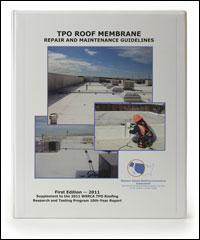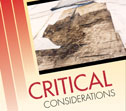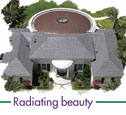
In June, the Western States Roofing Contractors Association (WSRCA) released TPO Roof Membrane Repair and Maintenance Guidelines. This new document provides contractor-developed recommendations for TPO membrane roof systems' maintenance and repair. The guidelines should be especially useful for building owners with TPO membrane roof systems on their buildings and roofing contractors who install such roof systems.
Repair guidelines
TPO Roof Membrane Repair and Maintenance Guidelines is a 150-page document published in a three-ring binder that contains more than 290 color photographs of specific conditions and repair procedures. The document is divided into four sections: introduction, review of methods, repair types, and glossary and references.
Section 1—Introduction provides an overview of the document and includes a statement that the document is intended to encourage careful periodic inspection, preventive maintenance and any necessary repairs to cost effectively extend TPO membrane roof systems' service lives.
Section 2—Review of Methods provides instructions for TPO membrane roof systems' general inspection, maintenance and repair techniques. Step-by-step instructions are provided for visual inspection and probing, membrane preparation for hot-air welding, preparing for TPO patches, proper hot-air welding, use of protective coatings, and tools and materials.
For example, to prepare older TPO membranes, the guidelines suggest an additional preparation step of scrubbing repair areas with a relatively abrasive pad and the membrane manufacturer's solvent to more thoroughly remove embedded dirt and restore the membrane's weldability.
When applying protective coatings to TPO membranes, making any necessary membrane repairs; washing the membrane, including scrubbing the membrane with detergent; and thoroughly rinsing the membrane are suggested before coating application.
Section 3—Repair Types provides step-by-step instructions and photographic illustrations for specific repair types, including field of membrane, membrane base and wall flashings, mechanical fastener defects, roof edge flashings, and roof drain and scupper repairs. Overall, the section provides repair techniques for 21 conditions.
In situations where an existing TPO membrane has aged to the point where welding to the existing membrane's top surface cannot be effectively achieved, underside patch placement and reverse-side welding are suggested. This repair technique may be especially useful when repairs are necessary to nonadhered (mechanically attached) membrane roof systems where the roof membrane is exhibiting visible surface deterioration.
Section 4—Glossary and References provides definitions for common roofing terms and a list of references applicable to inspection, maintenance and repair of TPO membrane roof systems.
Putting it to use
Although the document's foreword indicates the guidelines are intended to be applicable in the western region of the U.S., the information may be useful throughout the U.S. for maintaining and repairing TPO membrane roof systems.
Because the TPO repair guidelines are formatted and published in a three-ring binder, applicable pages can be photocopied and included with repair proposals and invoices to building owners. Similarly, photocopying applicable pages and giving them to field service crews may help provide specific step-by-step repair instructions.
When repairing warranted roof systems, be sure to coordinate repair procedures and materials with those of the warranting entity (manufacturer). In most instances, when making repairs, manufacturers will require using their own proprietary repair products to maintain manufacturers' warranties.
If you are involved in a TPO membrane roof system's design and specification or installation and repair, I encourage you to obtain and review WSRCA's TPO repair guidelines, which can be purchased from WSRCA by calling (650) 958-5411 or visiting www.wsrca.com.
Mark S. Graham is NRCA's associate executive director of technical services.



